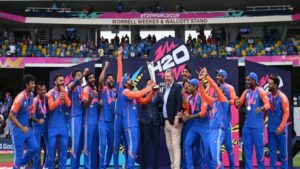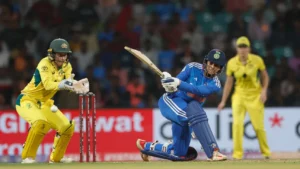Cricket is officially set to make its Olympic return at the Los Angeles 2028 (LA28) Summer Games. The International Olympic Committee (IOC) has approved a six-team T20 format for both men’s and women’s competitions. The decision was confirmed after months of deliberation, marking a historic moment as cricket rejoins the Olympic program for the first time since 1900.
The inclusion of T20—the shortest and most dynamic format of the sport—aims to align with the fast-paced nature of modern Olympic events and attract a broader global audience. Cricket’s growing popularity in countries like India, Australia, England, and across the Caribbean and Asia made it a strong candidate for Olympic inclusion.
The six-team event will be determined through ICC rankings and a qualification process, with top-performing nations expected to compete for the coveted Olympic gold. The move is expected to boost cricket’s international exposure and development, especially in non-traditional markets like the U.S., where LA28 will be hosted.
Cricket’s Olympic Journey – From 1900 to LA28
Cricket made its first and only Olympic appearance at the 1900 Paris Games, where Great Britain defeated France in a one-off match. Since then, despite cricket’s massive global following, especially in South Asia, the sport has remained absent from the Olympic arena.

Over the decades, various attempts were made to include cricket in the Olympics, but concerns about format duration, lack of global standardization, and scheduling conflicts with major international tournaments often stalled progress. The fast-growing popularity of the T20 format, however, made cricket more compatible with Olympic requirements.
The Six-Team Format – Structure, Rules, and Rationale
The LA28 T20 cricket tournament will feature six national teams in both men’s and women’s categories. The decision to limit participation to six teams is based on several factors:
- Time Constraints: The Olympics have a packed schedule. The T20 format allows matches to be completed in under four hours, and the six-team limit ensures the entire tournament can be held within a week.
- Venue Limitations: Cricket requires specific infrastructure, and hosting too many matches might burden Olympic organizers.
- Elite Competition: A smaller pool ensures high-quality competition, featuring top-ranked cricketing nations.
Format Overview:
- Group Stage: Two groups of three teams each
- Semifinals: Top two teams from each group qualify
- Final & Bronze Match: Winners of semifinals compete for gold; losers play for bronze
Participating Nations – Selection Criteria and Expectations

The International Cricket Council (ICC) and IOC will collaboratively determine the participating teams based on T20I rankings and qualification tournaments. Likely contenders include:
- India
- Australia
- England
- Pakistan
- New Zealand
- South Africa / West Indies / Bangladesh / USA (as host)
Why T20 is the Ideal Format for the Olympics
The T20 format has revolutionized cricket by making it more accessible and entertaining. Its inclusion in the Olympics is based on key advantages:
- Shorter Duration: Matches last about three hours, perfect for broadcast and live audiences.
- Spectator-Friendly: High-energy games with explosive batting and dynamic fielding appeal to both hardcore fans and casual viewers.
- Simplified Rules: Easier for non-cricketing audiences to understand compared to longer formats like Test and ODI cricket.
Boosting Cricket’s Popularity in Non-Traditional Markets

The Olympic spotlight could be transformative for cricket’s reach in markets where the sport has a limited presence, especially in North America, Europe, and East Asia. Key benefits include:
- Increased Visibility: Olympic exposure means millions of new viewers from diverse regions.
- Youth Engagement: Schools and communities may begin adopting cricket through Olympic associations.
- Government and Sponsorship Support: Recognition as an Olympic sport could unlock funding for grassroots programs.
Strategic Advantages for Traditional Cricket Nations
For established cricketing nations, Olympic inclusion presents several strategic advantages:
- National Recognition: Players representing their countries in the Olympics may receive enhanced honors and rewards.
- Brand Expansion: National cricket boards can leverage Olympic participation for global branding and commercial partnerships.
- Player Motivation: The opportunity to win an Olympic medal could be a career-defining milestone.
Role of the ICC and Coordination with the IOC
The International Cricket Council (ICC) has played a pivotal role in making cricket’s Olympic dream a reality. Working closely with the IOC, the ICC ensured that the format, scheduling, and logistics aligned with Olympic standards.
Key responsibilities of the ICC include:
- Designing qualification criteria
- Coordinating with national boards
- Ensuring anti-doping and ethical compliance
- Overseeing umpiring and match standards
Infrastructure and Venue Preparation in Los Angeles

Hosting cricket at the Olympics presents logistical challenges, especially in a non-cricket-dominant country like the USA. However, Los Angeles offers certain advantages:
- Multi-purpose Stadiums: Existing venues can be adapted for cricket
- Cricket Clubs in California: A growing expat population has led to increased cricket activity
- Investment in Infrastructure: The Olympics will catalyze the construction of purpose-built or convertible cricket grounds
Challenges and Criticisms
While the move is largely celebrated, there are challenges:
- Team Selection Pressure: With only six slots, many deserving nations may be left out
- Scheduling Conflicts: Clashes with major tournaments like IPL, PSL, and The Hundred
- Logistical Hurdles: Adapting U.S. venues for cricket will require time and investment
The Future of Cricket in the Olympics – Beyond LA28
LA28 is expected to serve as a litmus test. If successful, cricket could become a permanent fixture in the Olympics. There’s already talk of expanding the number of teams in future editions, possibly including 8 or even 12 teams.
The inclusion could also accelerate the creation of a global cricket calendar that integrates Olympic participation without clashing with other major events.
Frequently Asked Questions
Is cricket officially part of the LA28 Olympics?
Yes, cricket will be played in the T20 format at the 2028 Los Angeles Olympics.
When was cricket last part of the Olympics?
Cricket was last played in the 1900 Paris Olympics, over a century ago.
What format of cricket will be used?
The T20 format, which is fast-paced and widely popular, has been approved.
How many teams will participate?
A total of six teams will compete in both the men’s and women’s tournaments.
How will the teams qualify?
Teams will qualify based on ICC rankings and regional qualifiers.
Why was cricket included in the Olympics?
To increase global appeal and tap into cricket’s vast international fan base, especially in Asia.
Which countries are likely to participate?
India, Australia, England, South Africa, Pakistan, and New Zealand are strong contenders.
Will both men’s and women’s cricket be included?
Yes, both men’s and women’s six-team tournaments are part of the Olympic plan.
What is the expected impact on U.S. cricket?
Inclusion in LA28 is expected to boost cricket’s growth in the U.S., a non-traditional market.
How has the cricketing world reacted?
The response has been overwhelmingly positive, with global cricket boards and players welcoming the decision.
Conclusion
The approval of a six-team T20 cricket tournament for the LA28 Olympics is a landmark decision that reintroduces the sport to the Olympic fold after more than a century. This move not only honors cricket’s global appeal but also strategically places it within one of the world’s most-watched sporting events. With both men’s and women’s tournaments included, the initiative promotes equality and excitement for fans worldwide. As the qualification process unfolds, cricket boards and athletes are preparing to represent their nations on the Olympic stage. Beyond the medals, this step is set to expand cricket’s global footprint, particularly in emerging markets, and inspire a new generation of fans and players alike.

